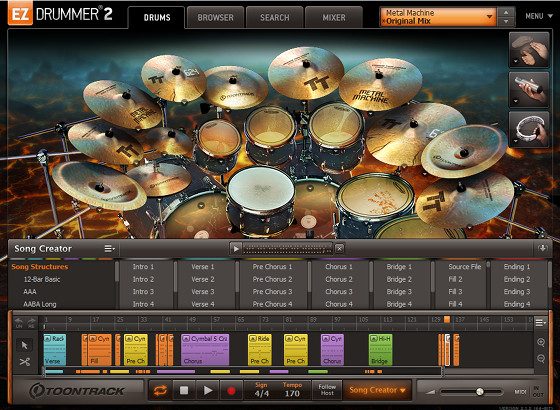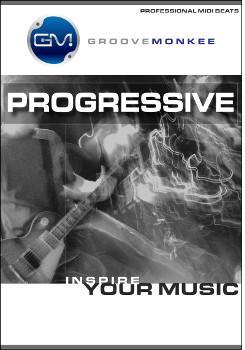200 and 260 Instant Drum Patterns
New, Download all the patterns for free! Download InstantDrumPatterns.ZIP. Enjoy, joel


Support is not available on this free product.
With 220 loops that feature drum fills and groove variations ready to drop right into your Metal songs. Metalcore Drum Loops V2 When you need drum loops that bring the pain you’ve met your match with Metalcore Drum Loops V2. 538 Mb of skull crushing drum loops and fills that are primed and ready to tear your speakers apart. Progressive Drum Loops that make it easy to produce great prog drum tracks So, you have written your 27-minute prog epic that has 7 different time signatures, several tempos and a fugue vocal part in the middle. You got the Rickenbacker 4001 ready and the old Ampeg SVT fired up. The mellotron choir samples (yeah.
At last, a solution to electronic drumming for people without a degree in percussion! Two all different book and software packages are available: 200 Instant Drum Patterns and 260 Instant Drum Patterns - for a total of 460 different patterns! They both include a variety of musical styles and fill patterns. About one-third of the patterns are fills.
Features
- All patterns on disk
- Patterns shown in both music and grid notation
- Includes fill patterns
- Works with any sequencer (Standard MIDI File format)
- Works with any keyboard, module or drum machine with percussion sounds
Midi Drum Patterns Free Metal Yard Art
200 and 260 Instant Drum Patterns Contents
| 200 Instant Drum Pattern (tm) Ballad (15 patterns) Blues (6 patterns) Bossa Nova (6 patterns) Cha-cha (3 patterns) Disco (15 patterns) Funk (45 patterns) Pop (15 patterns) Reggae (15 patterns) Rock (15 patterns) R&B (15 patterns) Swing (9 patterns) Samba (9 patterns) Shuffle (6 patterns) Ska (3 patterns) Twist (6 patterns) Plus Endings | 260 Instant Drum Patterns (tm) Afro-Cuban (15 patterns) Blues (9 patterns) Boogie (6 patterns) Bossa Nova (9 patterns) Cha Cha (6 patterns) Disco (21 patterns) Funk (30 patterns) Jazz (9 patterns) Pop (18 patterns) Reggae (21 patterns) R&B (18 patterns) Rock (27 patterns) Samba (9 patterns) Shuffle (9 patterns) Slow (18 patterns) Swing (9 patterns) Twist (6 patterns) Waltz (6 patterns) Plus Endings and more. |
You asked for it - hot rap beats! The 560+ unique measures werewritten by leading drum author Chuck Kerrigan for drummers. Thepatterns can be used for rap, house, dance, pop, jazz or any style ofmusic where you want a modern rap feel.
- Features
- Over 1000 measures on disk
- Patterns shown in music form with included book
- Includes an audio cassette
- Includes fill and Latin percussion parts
- Works with any sequencer (Standard MIDI File format)
- Works with any keyboard, module or drum machine with percussion sounds
All of the Instant Drum Patterns from Five Pin Press, 200 Instant Drum Patterns, 260 Instant Drum Patterns and Instant Rap Drum Patterns are in Standard MIDI Files format. They require a software or hardware sequencer that can read Standard MIDI Files.
The patterns use General MIDI percussion note mapping. They are organized one drum per track to make it easier to transpose notes if necessary for your particular instrument. They work with your computer and any keyboard, sound module or drum machine with percussion sounds. The included music book shows all patterns in both music and in grid notation for 200/260 Instant Drum Patterns.
If your percussion sound source does not use General MIDI mapping you will need to transpose each track for the proper drum sound. An easy way to do it is to transpose the entire track. Check your software manual for details.
Midi Drum Patterns Free Metal
Once you have the patterns setup you're ready create a custom rhythm track with your sequencer. The first step is to write your arrangement. Audition the drum patterns and select the style and alternate beats you like. Jot down the measure numbers you want to use. Next figure out where your fill patterns will be and the Instant Drum Pattern fills you want at each location. When you are done you should have a percussion arrangement for one time through the verse and chorus. Often those sections can be repeated to form the entire the song. The introduction and ending are usually handled separately.
To create the actual rhythm track you copy and paste in the measure view of your sequencer. Select the measures you want and copy them to unused tracks or at the end of our patterns in the desired order. Most sequencers have a measure view where you can copy and paste entire measures, check your particular software manual for instructions. Make sure you change the file name so you don't overwrite the original Instant Drum Pattern file. Once your song track is completed, you can either delete or mute the original tracks from Instant Drum Patterns. After you have the drum track add bass, other rhythm instruments and the rest of your parts. It is much easier to play syncopated rhythm parts with the Instant Rap Drum Patterns as the metronome rather than a conventional MIDI or audio metronome. You can use our patterns as a basic guide and modify the patterns for even more variety. If you want to create totally original patterns try the step entry mode of your sequencer.

You can also combine Instant Drum Patterns with an existing sequence. This also works to 'punch up' Band-in-a-Box generated sequences. Most sequencers can do this via the copy buffer. Create your arrangement and drum track similar to above and copy the drum track into the copy buffer. Load the second song sequence (which will overwrite the drum sequence but should leave the copy buffer) and paste the drum track into the second sequence. Check your sequencer manual for specific details on how to merge two sequences.
Here are few ideas on how to modify and get the most out of Instant Drum Patterns. An easy modification is to change one percussion sound to a different sound. For example, several patterns use a snare drum back beat on beats two and four. Try changing the snare drum to a rim shot, tom or hand claps for a few measures. Different accents can also be used effectively if you vary the accents slightly. This gives the patterns a more human feel. For example, when a drummer plays a roll, the left hand is slightly softer than the right hand (if the player is right handed). Added to this are techniques such as the paradiddle and other methods that rely on the stick bouncing off the snare head to sound some of the notes. This slight differences in volume makes drums sound 'real.' You can change also the overall dynamics by adding crescendos and decrescendos that match your songs dynamics. Sequencers with graphical editing make changing dynamics easy.
If you want to record your own patterns or add beats to these existing patterns with sequencing software, try recording in step-record mode. The step-record automatically records exactly on the beat. Another sequencer tip is to slide the patterns in time slightly. If you slide the drum track forward, the slight anticipation can be more driving while a slight lag in time puts the song 'in the groove.'
GM always uses MIDI Channel 10 for drums.
Two packages are currently available: 200 [Instant] Drum MachinePatterns and 260 [Instant] Drum Machine Patterns. Each packageconsists of a book in which all 200 or 260 patterns, breaks, andfills are written out in music notation and in drum machine gridnotation for entering into your drum machine in step time.
The best part is that a disk (IBM, Mac, or Atari) is included thatcontains the patterns in Standard MIDI File format. You just load thepatterns into your sequencer, click on Play, and away you go.Note-number assignments default to the General MIDI Percussion Map.Each drum sound is on an individual track, which makes transposingnote assignments easy in the event that your drum machine or soundmodule does not conform to the General MIDI map. A separate usersmanual includes convenient MIDI drum-note assignment charts forseveral popular synths and drum machines.
A broad range of styles is represented, from rock, pop, and bluesto reggae, ska, R&B, disco, Afro-Cuban, swing, shuffle, Latin,ballads, and marches, each with fills to match. Rap and hip-hopgrooves are conspicuously absent, though.
The patterns are well-crafted and definitely usable.Unfortunately, the differences between certain patterns are slight.For example, the Funk and R&B patterns sound so similar stylisticallyas to be cut from the same cloth. Other patterns, such as Swing,wouldn't fill the bill for me if I were programming a jazz or swingtune. In other words, don't get too hung up on the pattern labels;you still have to use your ears in the end. The breaks and fills areinteresting, but they sound a bit stiff, as they are 100% quantized.I would like to see the patterns 'swing' a bit more. Even so, most ofthe patterns groove, particularly the Samba and some of the otherLatin and Funk varieties.
The idea is to use the drum patterns as templates, starting pointsfrom which you can edit to your heart's content, adding andsubtracting, accenting, swinging, and switching sounds until you'vetweaked yourself into drum track heaven. For instance, adding furtherelements of 'humanizing' is up you and the capabilities of your drummachine or sequencer. (For 'humanizing' ideas, see 'The Feel Factor:Humanizing Your Sequences' in the October 1987 EM, and 'Make YourDrum Machine Swing' in the May 1992 issue.)
Overall, the 200/260 Drum Machine Patterns packages have a lot tooffer the non-drumming programmer. And by not having to start fromscratch, even drummer/programmers can save time and come up with somenew ideas.

Michael McFall is the former editor of Rhythm magazine. Currently,he heads VDO Productions, a video production company specializing inmusic instruction videos.

Excerpted from the November 1992 Electronic Musician magazine.Copyright 1992 Electronic Musician. Reported with the permission ofthe Publishers.

Comments are closed.